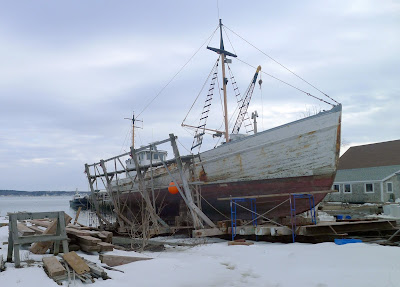Invented by a Scottish shipwright, the marine railway operates almost unchanged two hundred years later.
 |
| Packing oakum, by Carol L. Douglas |
This is the first year in a while that I won’t be painting through fit-out, the annual renovation of the Maine windjammer fleet. I leave for Scotland on Monday. By the time I return they’ll be mostly finished.
The windjammer fleet is annually hauled out of the water according to a very loose schedule, written in longhand and pinned to the wall of the office at North End Shipyard. These boats are very big and very old. They spend nearly all their lives in the water, where they’re prey to worms, barnacles, and other underwater stinkers. They need regular repainting and occasional replanking. The Coast Guard carefully inspects their nether regions as well.
 |
| Setting blocks, by Carol L. Douglas |
The marine railway, or patent slipway, was invented by a Scottish shipwright in 1818. Thomas Mortonwas looking for a cheaper, faster way of dry-docking boats in his Leith boatyard. As with so many brilliant ideas, his plan was deceptively simple. A boat would be secured to a wooden cradle while still floating in the water. This cradle would then be raised up a set of rails—the slipway—to dry land. A block and tackle arrangement would give a mechanical advantage, but the hoisting power came from men and mules.
 |
| Big-boned (Heritage), by Carol L. Douglas |
With the advent of steam power, a donkey engine replaced the living horsepower. Today it’s an old, repurposed diesel engine. Other than that, however, the railway at North End Shipyard could be from anytime in the last two hundred years.
While some of the work now involves air compressors and Bondo, there’s a lot of it that’s straight out of the past as well. Hulls are still caulked with oakum and a long caulking mallet. Paint is scraped away and then replaced with brushes, and the Coast Guard laboriously walks the length of the hull pinging every plank with a hammer to search out rot.
 |
| Striping (Captain Linda Lee), by Carol L. Douglas |
In most cases, the boats are out of the water only a few days. Sometimes the work they need barely outlasts a tide cycle. Conversely, the crew can find work that’s so extensive that they can’t get back in the water for a week or longer. Or weather can prevent hauling. Hence the vagaries of the schedule.
Those few days out of the water are hardly all the work that’s done every year on these boats. Their tenders were repaired and refinished in sheds over the winter; so too were the wooden blocks (pulleys) that the lines run through. Under their plastic covers, decks have been refinished, and repairs have been made to the below-deck accommodation for passengers. The masts are greased so the hoops can travel freely, and ratlines are retarred.
 |
| Coast Guard Inspection, by Carol L. Douglas |
Everything above the waterline will be painted from floats. The Coast Guard will make sure that all the lifesaving equipment works and that the crew knows how to use it. It’s an intense, laborious process, all so these beautiful vessels can parade proudly for five months a year.
Despite the immense usefulness of his invention, Thomas Morton did not get stinking rich. He earned a total of £5737 in royalties and a lump sum of £2500 from the House of Commons. That made his total profit around a million modern US dollars—not much, considering how widely the marine railway is still used today. Perhaps when I’m in Edinburgh, I will search out his old shipyard and give a nod to one of the many inventions through which the Scots changed the modern world.
There are still a few openings in my sketch-watercolor workshop aboard the schooner American Eagle, June 9-13, 2019. This is a class to learn how to catch landscape quickly and expressively in watercolor, pen and pencil. And my annual Sea & Sky workshop at Schoodic Institute in Acadia National Park has had a cancellation; I’m dying to know who’s going to take that last spot. For more information, email me.


